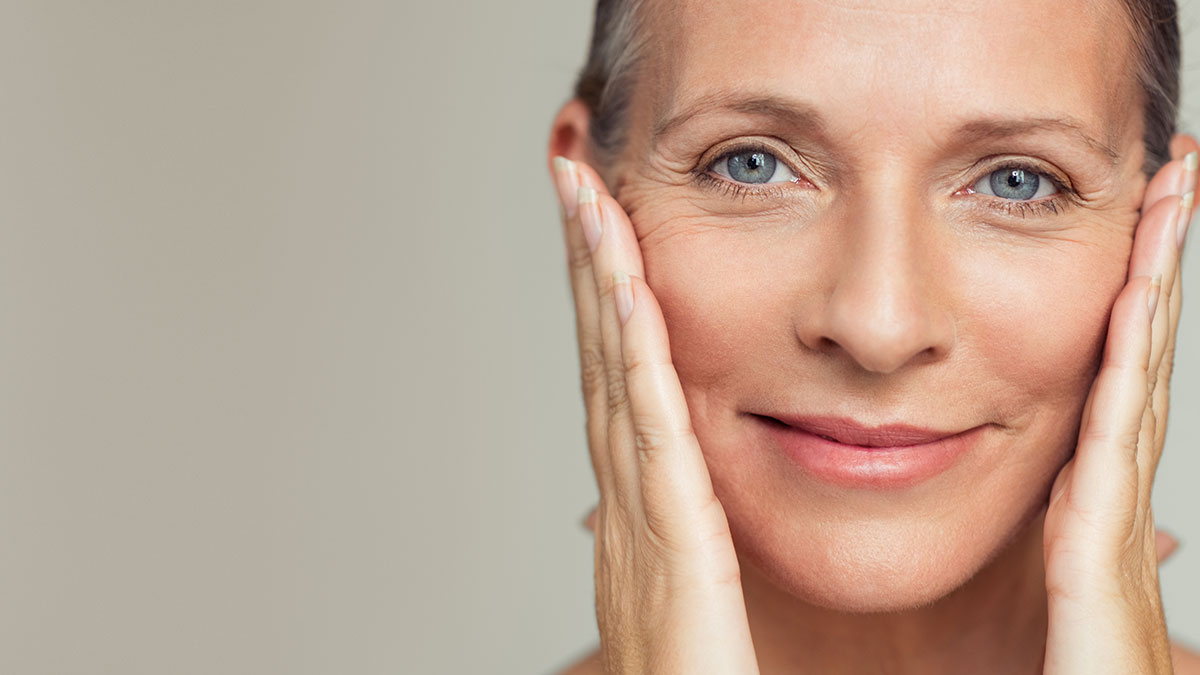Menopause face is a real thing. When we go through menopause stages, our faces begin to change in a variety of ways.
Some women will experience 1-2 symptoms, some women will experience 3-4 symptoms, and even still, some women will experience all the symptoms.
Menopause face can lead to loss of collagen, an increase in loose skin, production of wrinkles, thinning of the skin, dry skin, facial flushing, hyperpigmentation and age spots, bags under the eyes, and increased sun damage.
That’s why it’s important for us to stay on top of these symptoms.
It’s important for us to take menopause supplements that increase collagen production. It’s important for us to moisturize appropriately to minimize loose skin, thin skin, dry skin, and wrinkles. But above all, it’s important for us to know what we’re about to potentially face.
Table of Contents [hide]
Loss of Collagen
Does menopause age your face? Absolutely, it does, and it starts with the loss of collagen.
Collagen makes up approximately eighty percent of dry weight in the body when it comes to the adult skin. Without sufficient collagen production, a number of effects can play out.
To define, collagen is the protein that gives the skin firmness and elasticity. Menopause and skin elasticity are highly linked.
As time passes, collagen production starts to slow down, leading to an approximate thirty percent reduction in collagen in the first five years of menopause (due to the estrogen deficiency).
To start, less collagen directly produces wrinkles and saggy skin.
To add, protein synthesis throughout the body is naturally controlled by estrogens. In particular, collagen synthesis is maintained and directly controlled through active estrogen production.
When there’s less production of estrogen, it’s harder to keep up with normal collagen levels and repairs in the dermis of the skin. That’s why menopause makes it difficult to keep healthy collagen levels up and normal.
In turn, lack of collagen repair can potentially be worse if the skin is regularly exposed to UV rays. Why is this? Because UV rays are naturally destructive to collagen.
Unfortunately, ultimate loss of collagen can eventually lead to elastosis which may need treatment depending on the severity of the situation.
Loose Skin
Skin loses its mobility due to lack of estrogen during menopause. It’s a direct effect.
What happens is the elastic fibers and the glycosaminoglycans, also known as GAG’s, drop in production. This is another reason estrogen is so important, because without the hormone, these production levels won’t rise.
Without the plumb and bounciness provided to the skin and facial skin, the elastic fibers and GAG’s cannot do their job. The skin automatically becomes loose, and once it’s loose, it’s hard to tighten back up.
Production of Wrinkles
Estrogen and skin aging are very closely linked. And, when we think of skin aging, we automatically think of wrinkles, creasing, and things such as that.
When elastic fibers and GAG’s drop in production, facial wrinkles and creases automatically become more noticeable. Sometimes, the facial wrinkles and creases that are already present become deeper, too.
You see, what happens is when menopause starts, the lack of estrogen actually stimulates fat deposit production all over the body.
Commonly, these fat deposits settle in the abdomen, thighs, and buttocks.
When this situation starts to occur, the supportive fat below the skin on the face, in turn, starts to sag and produce wrinkles.
Again, the loss of mobility of the skin does not help reverse the production of wrinkles.
Thinning of The Skin
Rapid aging after menopause happens to almost every woman on the planet, and the skin is the first to start its rapid aging.
That’s why thinning of the skin, wrinkles, and dry skin symptoms pop up often.
When it comes to thinning of the skin, estrogen plays a huge part.
Estrogen directly controls the growth and maintenance of the capillaries in the dermis. Which means that the blood flow is drastically reduced to the capillaries during menopause.
In addition, the nutrients and oxygen supply is greatly reduced to the Stratum Germinativum or the Basal Cell layers of the dermis during menopause.
These things contribute to the thinning of the skin, which can absolutely lead to water loss and dry skin throughout the dermis of the face.
Thinning of the skin may also make the facial tissue more prone to bruising and tearing that’s likely to stick around longer than one would want it to.
Ultimately, the reason that the skin is thinning out is the loss of collagen, GAG’s, and natural water supply that the body would normally have.
Taking supplements may make this symptom of menopause a little less prominent, but talking to your doctor is always the right idea to have.
Dry Skin
Women over the age of forty typically have dry skin automatically. A number of reasons can contribute to this factor, but menopause is a close first to the condition of dry skin.
Hormones, including estrogen, play a huge part in keeping the skin hydrated. No matter how much water you drink, it will not matter.
If you don’t have the proper hormones circulating throughout the body, the skin on the face and everywhere else will become dry.
In fact, estrogen plays such a large role in maintaining hydrated skin that without it, you’ll need moisturizers and lotions to lubricate your facial tissue.
Estrogen also has its own role to play with hydration in regards to GAG’s and natural oil production, along with a normal water retention rate.
You may need a medicated moisturizer prescribed from your doctor to maintain skin that’s hydrated enough to minimize cracking and additional unwanted facial skin symptoms.
Many popular skincare lines may also know the best skincare for menopausal skin. For instance, body lotion for menopausal skin sites can dramatically improve dried out skin.
Face Flushing
Menopause red face can also be known as facial flushing. When you look at a woman that’s going through menopause, and you see a lot of pink or red in their face, they’re probably experiencing facial flushing.
It’s a tad embarrassing.
A flushed face menopause symptom is a lot more common than we’d think. Hot flashes and night sweats definitely antagonize them.
Hot flashes almost immediately cause facial flushing, especially considering the strong sense of warmth that occurs during a hot flash. These symptoms usually affect the facial skin the most, but can wander down towards the neck and chest.
In addition, sweating can increase facial flushing and redness almost automatically. The blood vessels in our face heat up so quickly that we can’t make the redness subtle, even if we wanted to or could try.
Why does this happen, though? A woman’s sympathetic nervous system is a lot more active after menopause.
This directly causes the arterioles to dilate throughout the face, therefore increasing sweat production, raising body temperatures, and affecting heart rates.
An estrogen deficiency that we experience through menopause is linked to a decrease in microcirculation, also. This, too, leads to automatic flushing of the facial tissue.
Hyperpigmentation and Age Spots
A lack of estrogen directly affects melanin production. Estrogen always keeps melanin production at a level where our bodies need it to be.
For instance, if you were ever a tanner back in the day, or currently are one, menopause has the potential to change the effects on your face with an increase in melanin production.
You see, when menopause happens, melanin synthesis increases with less estrogen present throughout the body. More melanin increases your risk for brown aging spots throughout the body and on the face.
Menopause skin discoloration may be another symptom that pops up due to hyperpigmentation after losing most of your estrogen production.
For better ways to combat this symptom, and similar discoloration instances, talk to your dermatologist.
Bags Under The Eyes
Fluctuating hormone levels while in menopause can result in fluid retention around the thin skin that’s underneath the eyes. The end results consist of bags under the eyes, normally.
Puffy and dry eyes can also be a symptom of fluctuating hormone levels. Which, in turn, can cause a lot more irritation around the skin of the eyes than we’d like to be putting up with.
Eye drops will likely help the puffiness and the dryness around the eyes, but the bags under the eyes cannot be helped with drops.
Unfortunately, insomnia can also contribute to the bags under the eyes menopause face symptoms.
When going through menopause, we experience a list of symptoms including but not limited to anxiety, depression, osteoporosis, and so on and so forth.
In fact, anxiety and menopause tingling are extremely common, but that’s a discussion for another time.
Insomnia, on the other hand, is a very popular symptom considering our hormones are out of whack and our bodies experience night sweats often.
With little sleep, bags can become bigger under the eyes with fluid retention, a decrease in estrogen production, and much more.
Sun Damage
Sun damage is something we should worry about our entire lives, considering skin cancer can be serious and deadly.
The main argument that health care professionals hold in regards to sun damage and menopause is this: the maintenance of melanocytes is primarily controlled by estrogen.
You see, the deeper into menopause we get, the less melanocytes we can maintain and produce. Instead of producing, the production dwindles down and the current ones we have floating around our bodies almost automatically degenerate.
In turn, our bodies start to produce too little melanin, making the skin lighter in appearance. Once our skin is lighter, we become more prone to sun damage and the other side effects sun damage can reign on us.












No Comments Add one
Leave a Comment